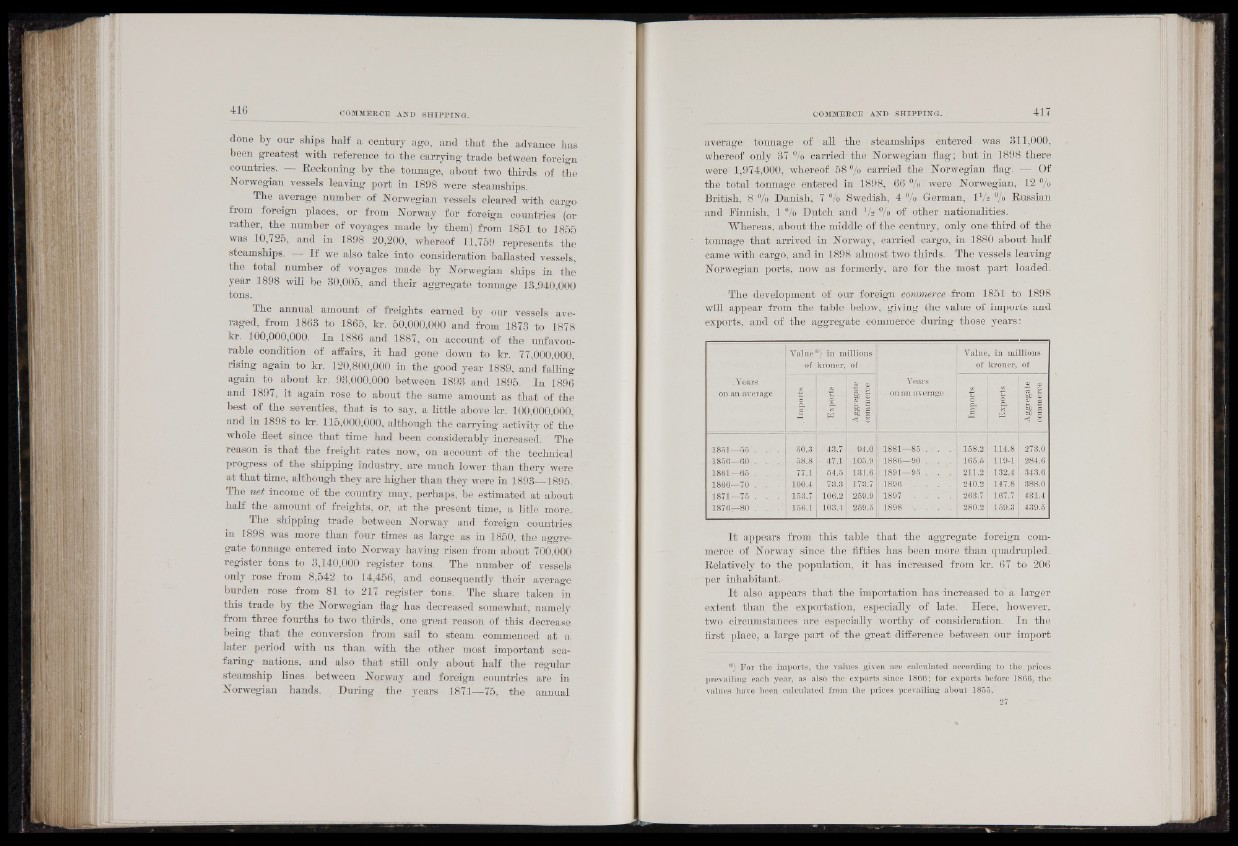
done by onr ships half a century ago, and that the advance has
been greatest with reference to the carrying trade between foreign
countries. — Reckoning by the tonnage, about two thirds of the
Norwegian vessels leaving port in 1898 were steamships.
The average number of Norwegian vessels cleared with cargo
from foreign places, or from Norway for foreign countries (or
rather, the number of voyages made by them) from 1851 to 1855
was 10,725, and in 1898 20,200, whereof 11,759 represents the
steamships. If we also take into consideration ballasted vessels,
the total number of voyages made by Norwegian ships in thè
year 1898 will be 30,005, and their aggregate tonnage 13,940 000
tons.
The annual amount of freights earned by our vessels averaged,
from 1863 to 1865, kr. 50,000,000 and from 1873 to 1878
kr. 100,000,000. In 1886 and 1887, on account of the unfavourable
condition of affairs, it had gone down to kr. 77,000,000,
rising again to kr. 120,800,000 in the good year 1889, and falling
again to about kr. 93,000,000 between 1893 and 1895. In 1896
and 1897, it again rose to about the same amount as that of the
best of the seventies, that is to say, a little above kr. 100,000,000,
and in 1898 to kr. 115,000,000, although the carrying activity of the
whole fleet since that time had been considerably increased. The
reason is that the freight rates now, on account of the technical
progress of the shipping industry, are much lower than thery were
at that time, although they are higher than they were in 1893-Bl895.
The net income of the country may, perhaps, be estimated at about
half the amount of freights, or, at the present time, a litle more.
The shipping trade between Norway and foreign countries
in 1898. was more than four times as large as in 1850, the aggregate
tonnage entered into Norway having risen from about 700,000
register tons to 3,140,000 register tons. The number of vessels
only rose from 8,542 to 14,456, and consequently their average
burden rose from 81 to 217 register tons. The share taken in
this trade by the Norwegian flag has decreased somewhat, namely
from three fourths to two thirds, one great reason of this decrease
being that the conversion from sail to steam commenced at a
later period with us than with the other most important seafaring
nations, and also that still only about half the regular
steamship linea between Norway and foreign countries are in
Norwegian hands. During the years 1871—75, the a.nnna.l
average tonnage of all the steamships entered was 311,000,
whereof only 37 % carried the Norwegian flag; but in 1898 there
were 1,974,000, whereof 58 % carried the Norwegian flag. B- Of
the total tonnage entered in 1898, 66 % were Norwegian,' 12 °/o
British, 8 % Danish, 7 °/o Swedish, 4 % German, 1 Vs % Russian
and F in n ish , 1 % Dutch and 1/a °/o of other nationalities.
Whereas, about the middle of the century, only one third of the
tonnage that arrived in Norway, carried cargo, in 1880 about half
came with cargo, and in 1898 almost two thirds. The vessels leaving
Norwegian ports, now as formerly, are for the most part loaded.
The development of our foreign commerce ■ from 1851 to 1898
will appear from the table below, giving the value of imports and
exports, and of the aggregate commerce during those years:
: Years
on an average
Yaïne*) in millions
of kroner, of
Years
on an average
Vaine, in millions
of kroner, of
C0
Exports
Aggregate
commerce
Imports
Exports
Aggregate -
commerce
' 1861;—55 . . . 50.3 43.7 94.0 1881—85 . H I 158.2 114.8 273.0
1856^60 . . , 58.8 47.1 .106.9 1886—90 . . . 165.5 119-1 284.6
1861—65 . . . 77.1, 64.6 131.6^ 1891—95 . . . 211.2 132.4 343.6
1866—70 . . . 100.4 73.3 173.7 1896 . . . . 240.2 147.8 388.0
1871—75 . H im 106.2 259.9 1897 . . . . 263.7 167.7 431.4
1876;—80 . . . i5 6 :i 103.4 259.5 1898 . . . . 280.2 159.3 439.5
I t appears from this table that the aggregate foreign commerce
of Norway since the fifties has been more than quadrupled.
Relatively to the population, it has increased from kr. 67 to 206
per inhabitant.-
I t also appears that the importation has increased to a larger
extent than the exportation, especially of late. Here, however,
two circumstances are especially worthy of consideration. In the
first placfe, a large part of the great difference between our import
*) For the imports, the values given are calculated according to the prices
prevailing each year, as also the exports since 1866; for exports before 1866, th e